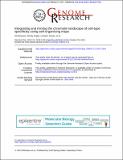Integrating and mining the chromatin landscape of cell-type specificity using self-organizing maps
Author(s)
Kellis, Manolis; Mortazavi, Ali; Pepke, Shirley; Jansen, Camden; Marinov, Georgi K.; Ernst, Jason; Hardison, Ross C.; Myers, Richard M.; Wold, Barbara J.; ... Show more Show less
DownloadMortazavi-2013-Integrating and mini.pdf (2.765Mb)
PUBLISHER_CC
Publisher with Creative Commons License
Creative Commons Attribution
Terms of use
Metadata
Show full item recordAbstract
We tested whether self-organizing maps (SOMs) could be used to effectively integrate, visualize, and mine diverse genomics data types, including complex chromatin signatures. A fine-grained SOM was trained on 72 ChIP-seq histone modifications and DNase-seq data sets from six biologically diverse cell lines studied by The ENCODE Project Consortium. We mined the resulting SOM to identify chromatin signatures related to sequence-specific transcription factor occupancy, sequence motif enrichment, and biological functions. To highlight clusters enriched for specific functions such as transcriptional promoters or enhancers, we overlaid onto the map additional data sets not used during training, such as ChIP-seq, RNA-seq, CAGE, and information on cis-acting regulatory modules from the literature. We used the SOM to parse known transcriptional enhancers according to the cell-type-specific chromatin signature, and we further corroborated this pattern on the map by EP300 (also known as p300) occupancy. New candidate cell-type-specific enhancers were identified for multiple ENCODE cell types in this way, along with new candidates for ubiquitous enhancer activity. An interactive web interface was developed to allow users to visualize and custom-mine the ENCODE SOM. We conclude that large SOMs trained on chromatin data from multiple cell types provide a powerful way to identify complex relationships in genomic data at user-selected levels of granularity.
Date issued
2013-10Department
Massachusetts Institute of Technology. Department of Electrical Engineering and Computer ScienceJournal
Genome Research
Publisher
Cold Spring Harbor Laboratory Press
Citation
Mortazavi, A., S. Pepke, C. Jansen, G. K. Marinov, J. Ernst, M. Kellis, R. C. Hardison, R. M. Myers, and B. J. Wold. “Integrating and Mining the Chromatin Landscape of Cell-Type Specificity Using Self-Organizing Maps.” Genome Research 23, no. 12 (December 1, 2013): 2136–2148.
Version: Final published version
ISSN
1088-9051